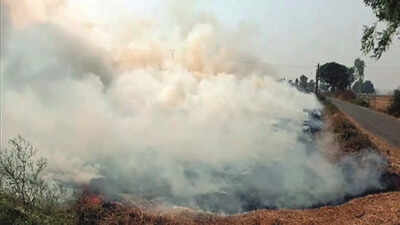- News
- City News
- chandigarh News
- Rise in allergies, farmers’ families too bear the brunt
Rise in allergies, farmers’ families too bear the brunt

Experts claim there is sufficient data available for the government to have handled the issue by now
CHANDIGARH: The rampant farm fires lit to get rid of paddy stubble are not only polluting the environment but even taking a toll on the health of people, including the families of farmers resorting to the quick-fix measure of clearing their fields for sowing wheat.
Where it has led to a spurt in cases of allergies, experts who have been tracking the problem feel sufficient data has been generated over the years for the state government to have effectively handled the issue by now.
Dr Prahlad Duggal, ENT surgeon from Amritsar, said cases of allergic bronchitis, allergic rhinitis, besides skin and eye allergies had gone up. “Families of farmers indulging in farm fires, especially their children, too are bearing the brunt of the menace. There are farmers who live in the fields and are more vulnerable. People from the adjoining urban centres are also affected by the pollution,” he said.
Dr Vitull K Gupta, Bathinda-based professor of medicine, who conducted a study in 2018 on the impact of pollution due to stubble burning on health and pulmonary functions, said, “Daily, I am getting cases of intractable cough in the OPD and it has started in the past 10-15 days. The claims of having provided adequate machinery to farmers to deal with paddy straw seem to be ringing hollow this season too. Had the state government effectively provided a viable alternative, it should have gone ahead with taking punitive action against farmers who would have still put their farms on fire.”
Dr Gupta’s study had found that stubble burning does not just worsen the condition of those with chronic obstructive pulmonary disorder but also of the healthy people living in close contact with smog that envelops the region around November.
One of the previous surveys involving 8,573 people conducted in 2016 had shown that 84.5% of the respondents suffered from health problems because of crop-stubble burning in Punjab. “The data is already there, and the trends repeat every year. An effective roadmap is, however, missing,” he said.
Meanwhile, a study by Susheel Mittal, former senior professor, school of chemistry and biochemistry, Thapar Institute of Engineering and Technology, in 2020 had found that the practice of biomass burning by a section of farmers in Punjab to get rid of paddy stubble was polluting the region’s air quality a little more than vehicular emissions and was second only to industrial emissions.
Other recent studies conducted in the state have found that more symptoms are experienced in rural areas as compared to urban areas and a majority of people experience a combination of one to four symptoms.
Most of the particulate matter released due to agriculture crop residue burning in the harvesting seasons are smaller than 10 microns, which means that these can easily enter the human lungs, causing some severe heart problems.
Where it has led to a spurt in cases of allergies, experts who have been tracking the problem feel sufficient data has been generated over the years for the state government to have effectively handled the issue by now.
Dr Prahlad Duggal, ENT surgeon from Amritsar, said cases of allergic bronchitis, allergic rhinitis, besides skin and eye allergies had gone up. “Families of farmers indulging in farm fires, especially their children, too are bearing the brunt of the menace. There are farmers who live in the fields and are more vulnerable. People from the adjoining urban centres are also affected by the pollution,” he said.
Dr Vitull K Gupta, Bathinda-based professor of medicine, who conducted a study in 2018 on the impact of pollution due to stubble burning on health and pulmonary functions, said, “Daily, I am getting cases of intractable cough in the OPD and it has started in the past 10-15 days. The claims of having provided adequate machinery to farmers to deal with paddy straw seem to be ringing hollow this season too. Had the state government effectively provided a viable alternative, it should have gone ahead with taking punitive action against farmers who would have still put their farms on fire.”
Dr Gupta’s study had found that stubble burning does not just worsen the condition of those with chronic obstructive pulmonary disorder but also of the healthy people living in close contact with smog that envelops the region around November.
One of the previous surveys involving 8,573 people conducted in 2016 had shown that 84.5% of the respondents suffered from health problems because of crop-stubble burning in Punjab. “The data is already there, and the trends repeat every year. An effective roadmap is, however, missing,” he said.
Meanwhile, a study by Susheel Mittal, former senior professor, school of chemistry and biochemistry, Thapar Institute of Engineering and Technology, in 2020 had found that the practice of biomass burning by a section of farmers in Punjab to get rid of paddy stubble was polluting the region’s air quality a little more than vehicular emissions and was second only to industrial emissions.
Other recent studies conducted in the state have found that more symptoms are experienced in rural areas as compared to urban areas and a majority of people experience a combination of one to four symptoms.
Most of the particulate matter released due to agriculture crop residue burning in the harvesting seasons are smaller than 10 microns, which means that these can easily enter the human lungs, causing some severe heart problems.
FOLLOW US ON SOCIAL MEDIA
FacebookTwitterInstagramKOO APPYOUTUBE
Start a Conversation
end of article









